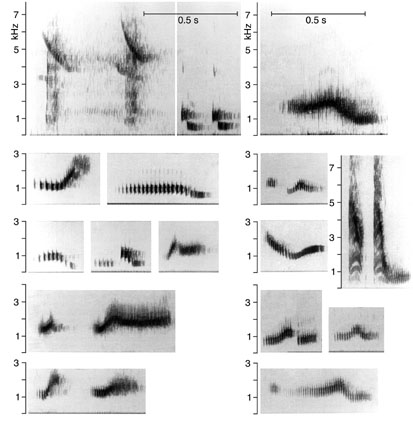
| Duets Duette |
back to Seibt |


|
Studies in field and laboratory
Males and females socially learn sex-specific vocal song elements. Each pair then combines these elements into a set of pair-specific duets, which remain constant for life.
Conclusions To achieve this, each individual has to select one element of its own overt repertoire according to an element just heard from the partner. Thus, an individual has to learn both male and female repertiore: it remembers that of the opposite sex as a silent repertoire. |
Literature
Seibt, Uta & Wickler, Wolfgang 2000: "Sympathetic song": the silent and the overt repertoire, exemplified with a dueting pair of the African slate-coloured boubou, Laniarius funebris. Ethology 106, 795-809
Wickler, Wolfgang & Seibt, Uta 1982: Song splitting in the evolution of dueting. Zeitschrift für Tierpsychologie 59, 127-140
Wickler, Wolfgang & Seibt, Uta 1982: Dueting and the pair bond. Animal Behaviour 30, 943-944
Wickler, Wolfgang & Seibt, Uta 1980: Vocal dueting and the pair bond. II. Unisono dueting of the African forest weaver, Symplectes bicolor. Zeitschrift für Tierpsychologie 52, 217-226
Wickler, Wolfgang & Seibt, Uta 1980: Einflüsse auf Paarpartner und Rivalen in "Duett-Kämpfen" revierverteidigender Vögel. Journal für Ornithologie 121, 162-170
Seibt, Uta & Wickler, Wolfgang 1977: Ein Stimmfühlungs-Duett beim Hornraben, Bucorvus leadbeateri (Vigors). Journal für Ornithologie 118, 51-98
Seibt, Uta & Wickler, Wolfgang 1977: Duettieren als Revier-Anzeige bei Vögeln. Zeitschrift für Tierpsychologie 43, 180-187
Additional Literature
Wickler, Wolfgang & Lunau, K. 1996: How do East African bush shrikes Laniarius funebris recognize male and female tutors during gender dialect development? Naturwissenschaften 83, 579-580
Wickler, Wolfgang 1980: Vocal dueting and the pair bond. I. Coyness and partner commitment. A hypothesis. Zeitschrift für Tierpsychologie 52, 201-209
Wickler, Wolfgang 1976: Duetting songs in birds: Biological significance of stationary and non-stationary processes. Journal of Theoretical Biology 61, 493-497
Wickler, Wolfgang 1974: Über die Beeinflussung des Partners im Duettgesang der Schmätzerdrossel Cossypha heuglini Hartlaub (Aves, Turdidae). Zeitschrift für Tierpsychologie 36, 128-136
Wickler, Wolfgang 1973: Artunterschiede im Duettgesang zwischen Trachyphonus d'arnaudii usambiro und den anderen Unterarten von T. d'arnaudii. Journal für Ornithologie 114, 123-128
Wickler, Wolfgang 1972: Aufbau und Paarspezifität des Gesangsduettes von Laniarius funebris (Aves, Passeriformes, Laniidae). Zeitschrift für Tierpsychologie 30, 464-476
Wickler, Wolfgang 1972: Duettieren zwischen artverschiedenen Vögeln im Freiland. Zeitschrift für Tierpsychologie 31, 98-103
von Helversen, Dagmar & Wickler, Wolfgang 1971: Über den Duettgesang des afrikanischen Drongo, Dicrurus adsimilis. Zeitschrift für Tierpsychologie 29, 301-321
Albrecht, Helmut & Wickler, Wolfgang 1968: Freilandbeobachtungen zur "Begrüßungszeremonie" des Schmuckbartvogels Trachyphonus d'arnaudii (Prévost u. Des Murs). Journal für Ornithologie 109, 255-263